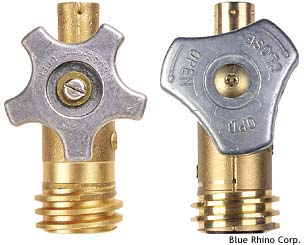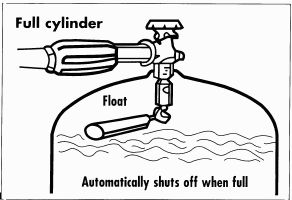OPD - Overfilling Protection Device
As of April 1, 2002, cylinders without OPDs cannot be refilled!
Beginning October 1, 1998, all newly manufactured small propane cylinders (capacity of 4 pounds up to 40 pounds) were required to be equipped with a over filling prevention device (OPD).
Overfilling Protection Device
Information on the new OPD valves from National Propane Gas Association,
NPGA #3100.
In most cases, consumers can tell if a propane tank has an OPD valve by the handles. If the handle is round or star-shaped (left) their cylinder is outdated. A triangular handle (right) indicates an updated cylinder.
What is an OPD?
Required by national fire and safety standards, an OPD is a safety feature that helps prevent small propane cylinders from being overfilled.
Why have an OPD?
There are limits on how much propane can be put into a cylinder. A properly filled cylinder will have a vapor space left in the top of the cylinder to allow room for expansion of the liquid with a change in atmospheric temperature.An overfilling prevention device is a secondary means of assuring that cylinders are not overfilled.
What can happen if a cylinder is overfilled?
An overfilled cylinder doesn't have enough space left if the liquid expands when exposed to warmer temperatures. This can cause an increase in cylinder pressure and create potentially hazardous conditions, such as:
- The pressure relief valve may open, discharging propane from the cylinder.
- Propane liquid could enter the piping system, resulting in higher than normal pressures to appliances.
How does an OPD work?
During the refilling process, a valve inside the cylinder closes when the proper level of propane is reached. Since the OPD currently in use measures the volume of propane in the cylinder, the weight of the propane will vary depending on its temperature. Check the posted information where you purchase propane to determine the net weight of propane in your cylinder.
When will OPD-equipped cylinders be available?
New cylinders already have OPDs. As of October 1, 1998, all new DOT cylinders with capacities of 4 pounds up to 40 pounds must have OPD valves.
Will my old cylinder need an OPD valve?
Yes, an OPD must be installed on your old cylinder. If your cylinder is inspected for requalification before April 1, 2002, an OPD-equipped valve will be installed at that time. (All DOT cylinders require periodic requalification to ensure that they are safe for continued use.) Even if your cylinder is not inspected for requalification before April 1, 2002, it must still have an OPD-equipped valve installed on it by that date.
What happens if I don't have an OPD installed on my cylinder?
As of April 1, 2002, cylinders without OPDs cannot be refilled.
How can I tell if a cylinder has an OPD?
There are at least two ways to identify OPD equipped cylinders. New cylinder wrappers and/or warning labels will include this information. Second, most cylinders with OPDs have special triangular handwheels with the letters "OPD." (However, some OPDs were produced before the letters on the valve handles and valve bodies were required so check the wrapper or label or ask your propane refiller to identify the type of valve on your cylinder.)
For more on propane safety give us a call or visit the Coalition for Portable Propane Product Safety web site.


